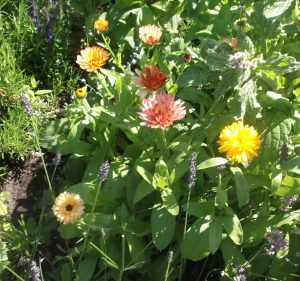Not quite so big on poetry this week, though the outlines of my ‘red yellow blue’ project are falling into place. The herb beds are getting cleared and rearranged so that plants have more room to spread themselves about. All the plants I have moved seem to be thriving and the violets have even thrown up a few blossoms in this unseasonably mild weather we have had.

In the space to the right I have planted the first of the dye plants, a bog myrtle, which also has the merit of being an insect repellent, and there is plenty of room for a new rosa gallica officinalis

as the old one – which was about twenty years old, so probably not going to last much longer – had a lot of problems with rust and throwing up suckers with vicious long thorns that were hell to get out. There will also be dyer’s greenweed and woad, I hope, and madder, which will have to go into pots, as it is seriously invasive in the ground.
The greenhouse is clean and tidy – I don’t know when it ever looked so tidy –

and the more tender plants are going in for the winter. There are still bulbs to plant, and then the indoor work will begin.
There will be a serious amount of research going on; I have Wild Colour by Jenny Dean for the practical stuff, and The Colour Cauldron:The History and Use of Natural Dyes in Scotland by Su Grierson for the historical references. Oddly, though it was written and published in Scotland, I’ve had to import it from the USA, but is a fascinating record of the many plants, both local and imported, used in Scotland. In a very satisfactory development, some of the worst weeds in my garden can be used this way – horsetail and nettle for yellow, and ivy for greys and dark olive greens. If I could find a use for ground elder, I’d be sorted! And I have scored a copy of the iconic The Subversive Stitch by Roszika Parker for a take on the place textile art has had in the lives of women through the ages.
And this week, I’ll be trying the first dyes, using acorns, cherry bark and ivy all gathered from the territory, which has given me a new awareness of what is happening in the landscape around me, and some different ways of interacting and creating a homage to my home place.

